Research Dissertation: Reducing Pharmacy Dispensing Errors in the UK
VerifiedAdded on 2022/12/30
|20
|7189
|57
Project
AI Summary
This research dissertation investigates the critical issue of pharmacy dispensing errors within the UK healthcare system, focusing on their reduction. The study begins with an introduction that outlines the aim of exploring methods to minimize these errors, along with specific objectives and research questions. The rationale highlights the significant impact of dispensing errors on patient safety, healthcare costs, and the need for preventive measures. The dissertation also includes a thorough literature review, examining various themes such as the prevalence of dispensing errors, interventions to prevent them, and strategies for mitigation, particularly in hospital settings. The methodology section details the research design, approach, data collection methods, sampling techniques, and ethical considerations. The research aims to analyze the causes of errors, evaluate current interventions, and propose effective strategies to enhance patient safety and improve overall healthcare outcomes. The research also underlines the significance of the study for pharmacists, patients, and other researchers. The dissertation concludes with a summary of findings, conclusions, and recommendations for reducing dispensing errors in UK pharmacies.
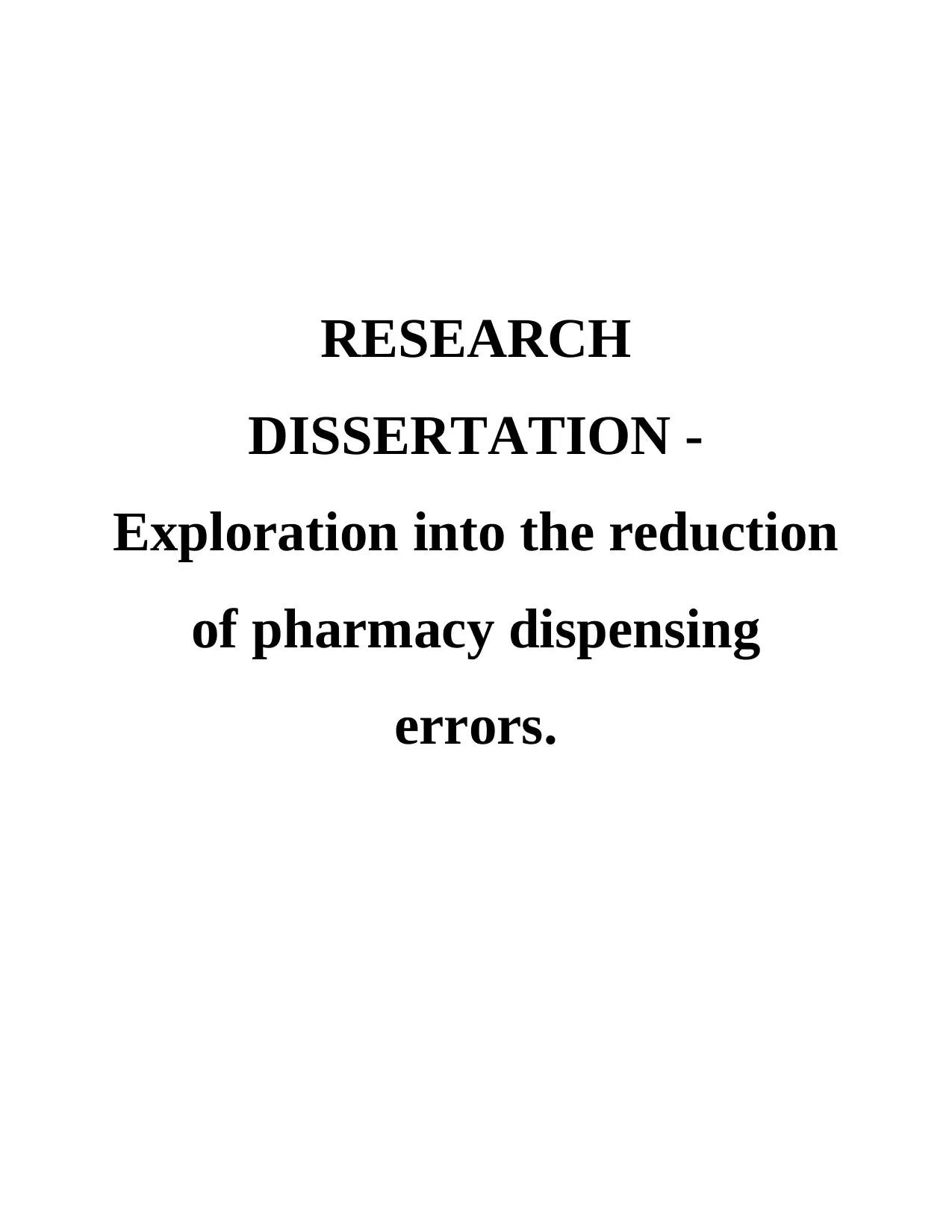
RESEARCH
DISSERTATION -
Exploration into the reduction
of pharmacy dispensing
errors.
DISSERTATION -
Exploration into the reduction
of pharmacy dispensing
errors.
Paraphrase This Document
Need a fresh take? Get an instant paraphrase of this document with our AI Paraphraser
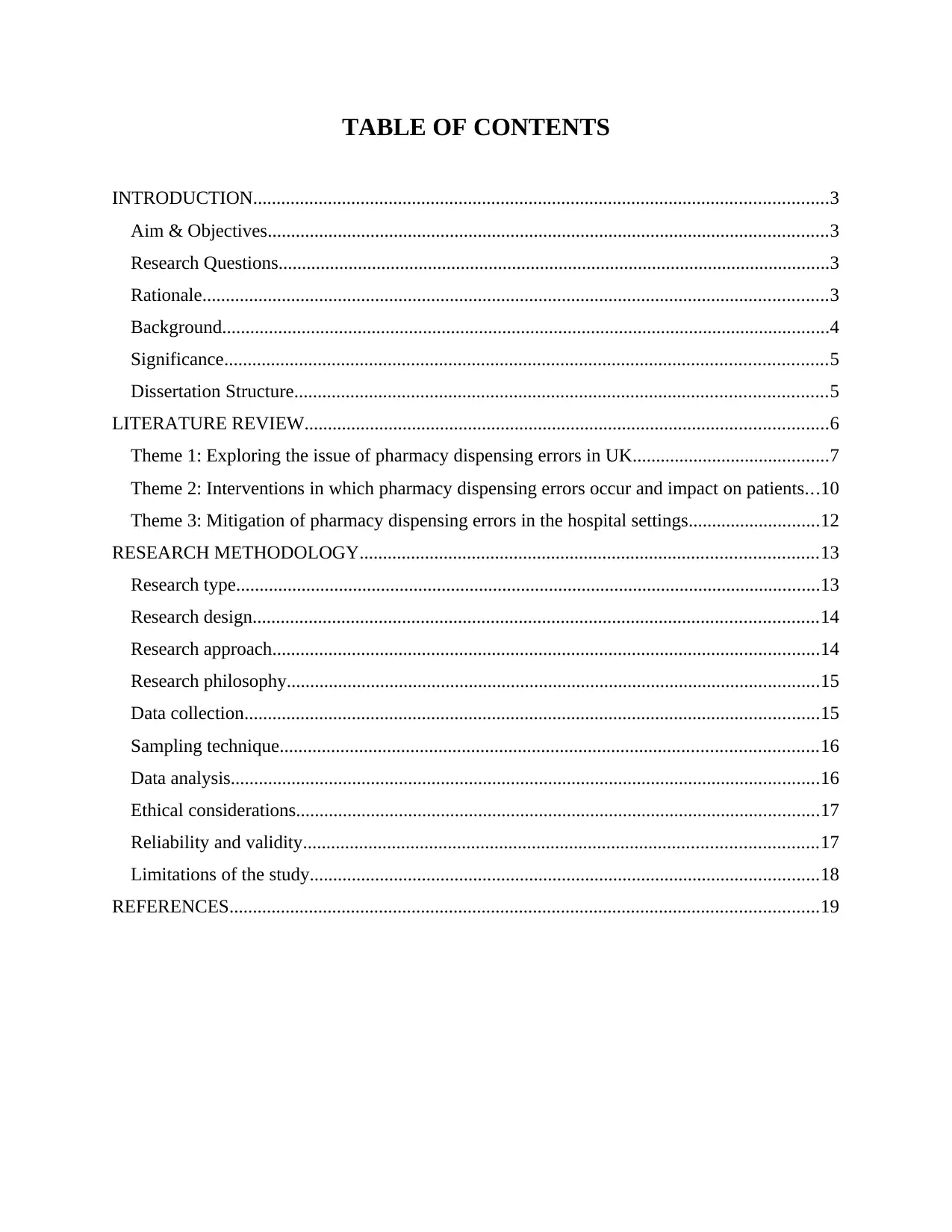
TABLE OF CONTENTS
INTRODUCTION...........................................................................................................................3
Aim & Objectives........................................................................................................................3
Research Questions......................................................................................................................3
Rationale......................................................................................................................................3
Background..................................................................................................................................4
Significance.................................................................................................................................5
Dissertation Structure..................................................................................................................5
LITERATURE REVIEW................................................................................................................6
Theme 1: Exploring the issue of pharmacy dispensing errors in UK..........................................7
Theme 2: Interventions in which pharmacy dispensing errors occur and impact on patients...10
Theme 3: Mitigation of pharmacy dispensing errors in the hospital settings............................12
RESEARCH METHODOLOGY..................................................................................................13
Research type.............................................................................................................................13
Research design.........................................................................................................................14
Research approach.....................................................................................................................14
Research philosophy..................................................................................................................15
Data collection...........................................................................................................................15
Sampling technique...................................................................................................................16
Data analysis..............................................................................................................................16
Ethical considerations................................................................................................................17
Reliability and validity..............................................................................................................17
Limitations of the study.............................................................................................................18
REFERENCES..............................................................................................................................19
INTRODUCTION...........................................................................................................................3
Aim & Objectives........................................................................................................................3
Research Questions......................................................................................................................3
Rationale......................................................................................................................................3
Background..................................................................................................................................4
Significance.................................................................................................................................5
Dissertation Structure..................................................................................................................5
LITERATURE REVIEW................................................................................................................6
Theme 1: Exploring the issue of pharmacy dispensing errors in UK..........................................7
Theme 2: Interventions in which pharmacy dispensing errors occur and impact on patients...10
Theme 3: Mitigation of pharmacy dispensing errors in the hospital settings............................12
RESEARCH METHODOLOGY..................................................................................................13
Research type.............................................................................................................................13
Research design.........................................................................................................................14
Research approach.....................................................................................................................14
Research philosophy..................................................................................................................15
Data collection...........................................................................................................................15
Sampling technique...................................................................................................................16
Data analysis..............................................................................................................................16
Ethical considerations................................................................................................................17
Reliability and validity..............................................................................................................17
Limitations of the study.............................................................................................................18
REFERENCES..............................................................................................................................19
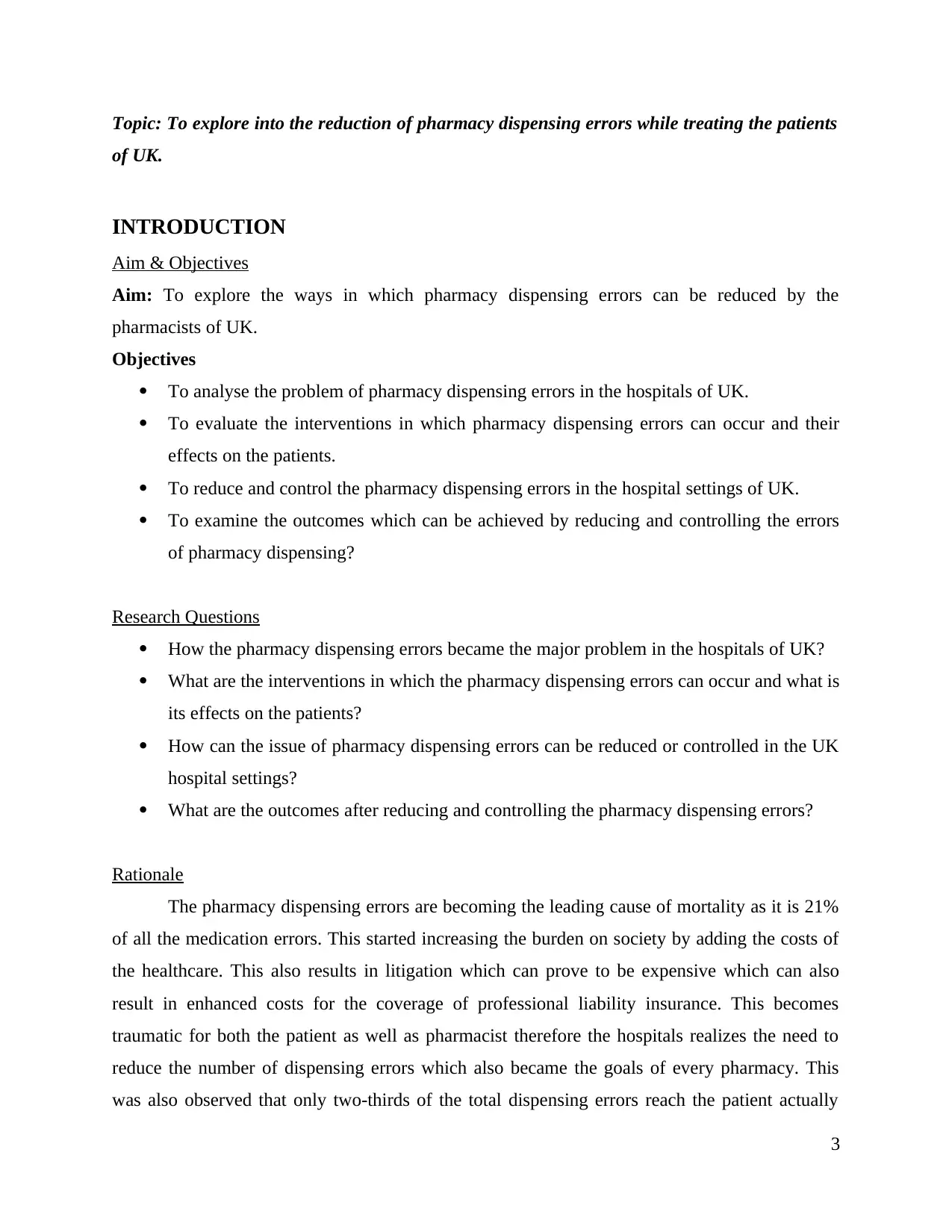
Topic: To explore into the reduction of pharmacy dispensing errors while treating the patients
of UK.
INTRODUCTION
Aim & Objectives
Aim: To explore the ways in which pharmacy dispensing errors can be reduced by the
pharmacists of UK.
Objectives
To analyse the problem of pharmacy dispensing errors in the hospitals of UK.
To evaluate the interventions in which pharmacy dispensing errors can occur and their
effects on the patients.
To reduce and control the pharmacy dispensing errors in the hospital settings of UK.
To examine the outcomes which can be achieved by reducing and controlling the errors
of pharmacy dispensing?
Research Questions
How the pharmacy dispensing errors became the major problem in the hospitals of UK?
What are the interventions in which the pharmacy dispensing errors can occur and what is
its effects on the patients?
How can the issue of pharmacy dispensing errors can be reduced or controlled in the UK
hospital settings?
What are the outcomes after reducing and controlling the pharmacy dispensing errors?
Rationale
The pharmacy dispensing errors are becoming the leading cause of mortality as it is 21%
of all the medication errors. This started increasing the burden on society by adding the costs of
the healthcare. This also results in litigation which can prove to be expensive which can also
result in enhanced costs for the coverage of professional liability insurance. This becomes
traumatic for both the patient as well as pharmacist therefore the hospitals realizes the need to
reduce the number of dispensing errors which also became the goals of every pharmacy. This
was also observed that only two-thirds of the total dispensing errors reach the patient actually
3
of UK.
INTRODUCTION
Aim & Objectives
Aim: To explore the ways in which pharmacy dispensing errors can be reduced by the
pharmacists of UK.
Objectives
To analyse the problem of pharmacy dispensing errors in the hospitals of UK.
To evaluate the interventions in which pharmacy dispensing errors can occur and their
effects on the patients.
To reduce and control the pharmacy dispensing errors in the hospital settings of UK.
To examine the outcomes which can be achieved by reducing and controlling the errors
of pharmacy dispensing?
Research Questions
How the pharmacy dispensing errors became the major problem in the hospitals of UK?
What are the interventions in which the pharmacy dispensing errors can occur and what is
its effects on the patients?
How can the issue of pharmacy dispensing errors can be reduced or controlled in the UK
hospital settings?
What are the outcomes after reducing and controlling the pharmacy dispensing errors?
Rationale
The pharmacy dispensing errors are becoming the leading cause of mortality as it is 21%
of all the medication errors. This started increasing the burden on society by adding the costs of
the healthcare. This also results in litigation which can prove to be expensive which can also
result in enhanced costs for the coverage of professional liability insurance. This becomes
traumatic for both the patient as well as pharmacist therefore the hospitals realizes the need to
reduce the number of dispensing errors which also became the goals of every pharmacy. This
was also observed that only two-thirds of the total dispensing errors reach the patient actually
3
⊘ This is a preview!⊘
Do you want full access?
Subscribe today to unlock all pages.

Trusted by 1+ million students worldwide
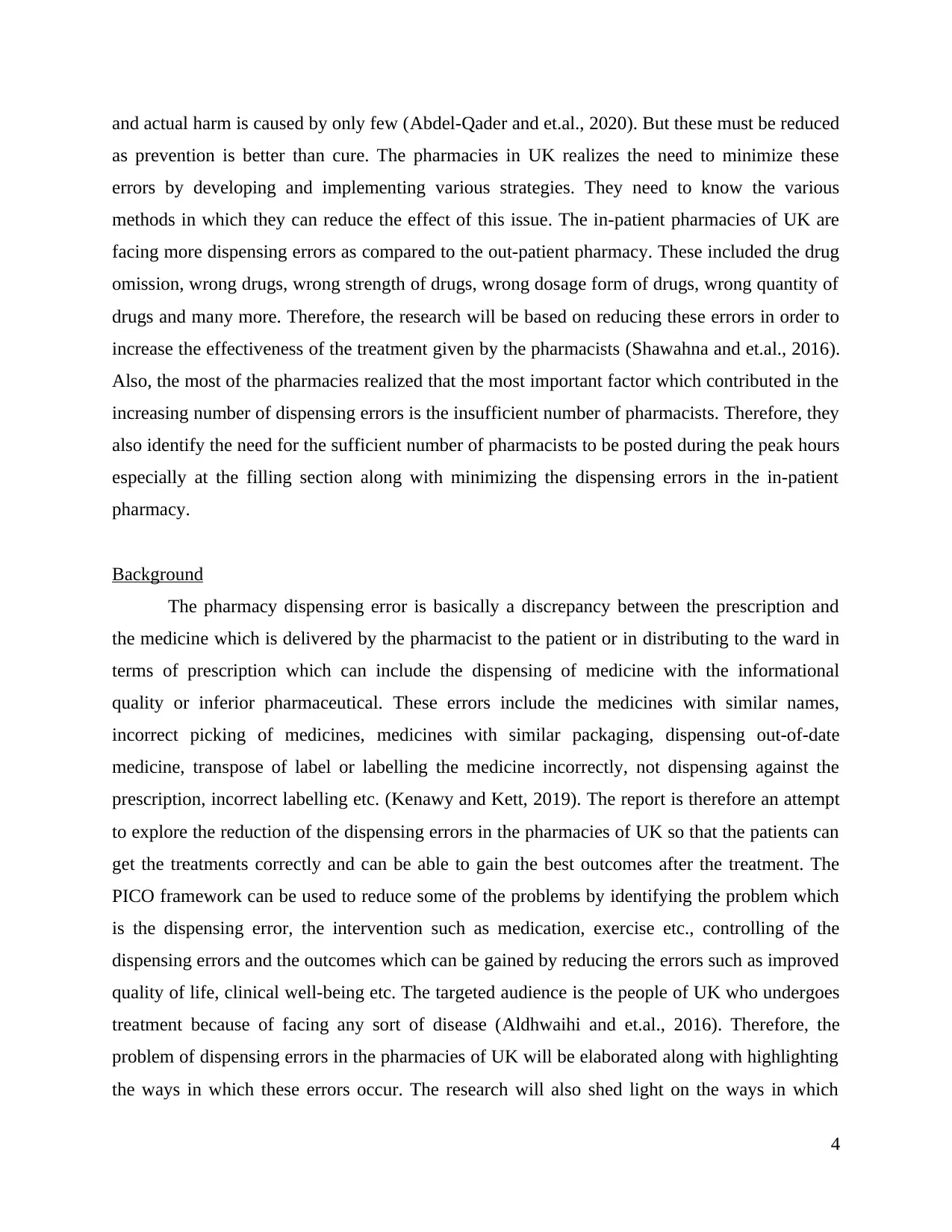
and actual harm is caused by only few (Abdel-Qader and et.al., 2020). But these must be reduced
as prevention is better than cure. The pharmacies in UK realizes the need to minimize these
errors by developing and implementing various strategies. They need to know the various
methods in which they can reduce the effect of this issue. The in-patient pharmacies of UK are
facing more dispensing errors as compared to the out-patient pharmacy. These included the drug
omission, wrong drugs, wrong strength of drugs, wrong dosage form of drugs, wrong quantity of
drugs and many more. Therefore, the research will be based on reducing these errors in order to
increase the effectiveness of the treatment given by the pharmacists (Shawahna and et.al., 2016).
Also, the most of the pharmacies realized that the most important factor which contributed in the
increasing number of dispensing errors is the insufficient number of pharmacists. Therefore, they
also identify the need for the sufficient number of pharmacists to be posted during the peak hours
especially at the filling section along with minimizing the dispensing errors in the in-patient
pharmacy.
Background
The pharmacy dispensing error is basically a discrepancy between the prescription and
the medicine which is delivered by the pharmacist to the patient or in distributing to the ward in
terms of prescription which can include the dispensing of medicine with the informational
quality or inferior pharmaceutical. These errors include the medicines with similar names,
incorrect picking of medicines, medicines with similar packaging, dispensing out-of-date
medicine, transpose of label or labelling the medicine incorrectly, not dispensing against the
prescription, incorrect labelling etc. (Kenawy and Kett, 2019). The report is therefore an attempt
to explore the reduction of the dispensing errors in the pharmacies of UK so that the patients can
get the treatments correctly and can be able to gain the best outcomes after the treatment. The
PICO framework can be used to reduce some of the problems by identifying the problem which
is the dispensing error, the intervention such as medication, exercise etc., controlling of the
dispensing errors and the outcomes which can be gained by reducing the errors such as improved
quality of life, clinical well-being etc. The targeted audience is the people of UK who undergoes
treatment because of facing any sort of disease (Aldhwaihi and et.al., 2016). Therefore, the
problem of dispensing errors in the pharmacies of UK will be elaborated along with highlighting
the ways in which these errors occur. The research will also shed light on the ways in which
4
as prevention is better than cure. The pharmacies in UK realizes the need to minimize these
errors by developing and implementing various strategies. They need to know the various
methods in which they can reduce the effect of this issue. The in-patient pharmacies of UK are
facing more dispensing errors as compared to the out-patient pharmacy. These included the drug
omission, wrong drugs, wrong strength of drugs, wrong dosage form of drugs, wrong quantity of
drugs and many more. Therefore, the research will be based on reducing these errors in order to
increase the effectiveness of the treatment given by the pharmacists (Shawahna and et.al., 2016).
Also, the most of the pharmacies realized that the most important factor which contributed in the
increasing number of dispensing errors is the insufficient number of pharmacists. Therefore, they
also identify the need for the sufficient number of pharmacists to be posted during the peak hours
especially at the filling section along with minimizing the dispensing errors in the in-patient
pharmacy.
Background
The pharmacy dispensing error is basically a discrepancy between the prescription and
the medicine which is delivered by the pharmacist to the patient or in distributing to the ward in
terms of prescription which can include the dispensing of medicine with the informational
quality or inferior pharmaceutical. These errors include the medicines with similar names,
incorrect picking of medicines, medicines with similar packaging, dispensing out-of-date
medicine, transpose of label or labelling the medicine incorrectly, not dispensing against the
prescription, incorrect labelling etc. (Kenawy and Kett, 2019). The report is therefore an attempt
to explore the reduction of the dispensing errors in the pharmacies of UK so that the patients can
get the treatments correctly and can be able to gain the best outcomes after the treatment. The
PICO framework can be used to reduce some of the problems by identifying the problem which
is the dispensing error, the intervention such as medication, exercise etc., controlling of the
dispensing errors and the outcomes which can be gained by reducing the errors such as improved
quality of life, clinical well-being etc. The targeted audience is the people of UK who undergoes
treatment because of facing any sort of disease (Aldhwaihi and et.al., 2016). Therefore, the
problem of dispensing errors in the pharmacies of UK will be elaborated along with highlighting
the ways in which these errors occur. The research will also shed light on the ways in which
4
Paraphrase This Document
Need a fresh take? Get an instant paraphrase of this document with our AI Paraphraser
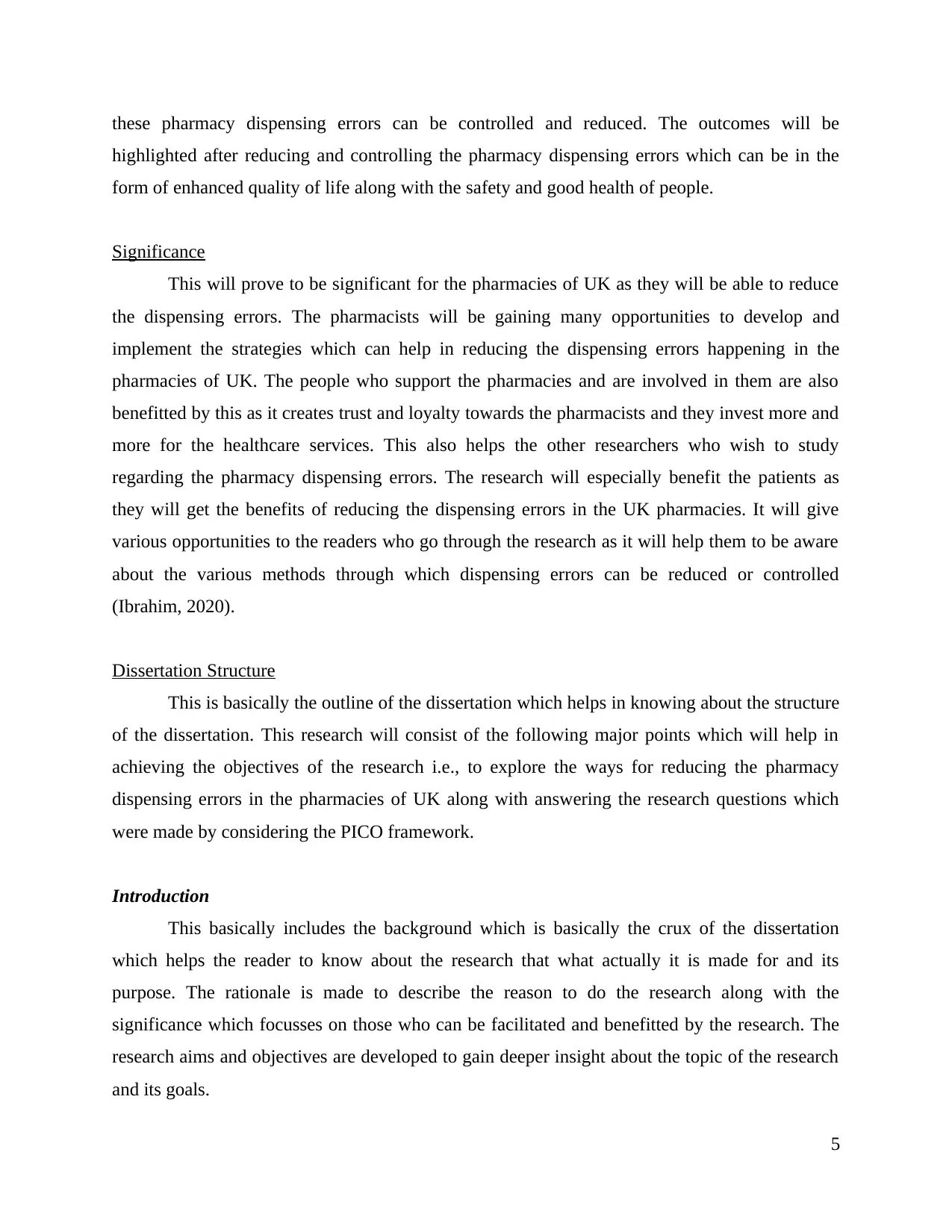
these pharmacy dispensing errors can be controlled and reduced. The outcomes will be
highlighted after reducing and controlling the pharmacy dispensing errors which can be in the
form of enhanced quality of life along with the safety and good health of people.
Significance
This will prove to be significant for the pharmacies of UK as they will be able to reduce
the dispensing errors. The pharmacists will be gaining many opportunities to develop and
implement the strategies which can help in reducing the dispensing errors happening in the
pharmacies of UK. The people who support the pharmacies and are involved in them are also
benefitted by this as it creates trust and loyalty towards the pharmacists and they invest more and
more for the healthcare services. This also helps the other researchers who wish to study
regarding the pharmacy dispensing errors. The research will especially benefit the patients as
they will get the benefits of reducing the dispensing errors in the UK pharmacies. It will give
various opportunities to the readers who go through the research as it will help them to be aware
about the various methods through which dispensing errors can be reduced or controlled
(Ibrahim, 2020).
Dissertation Structure
This is basically the outline of the dissertation which helps in knowing about the structure
of the dissertation. This research will consist of the following major points which will help in
achieving the objectives of the research i.e., to explore the ways for reducing the pharmacy
dispensing errors in the pharmacies of UK along with answering the research questions which
were made by considering the PICO framework.
Introduction
This basically includes the background which is basically the crux of the dissertation
which helps the reader to know about the research that what actually it is made for and its
purpose. The rationale is made to describe the reason to do the research along with the
significance which focusses on those who can be facilitated and benefitted by the research. The
research aims and objectives are developed to gain deeper insight about the topic of the research
and its goals.
5
highlighted after reducing and controlling the pharmacy dispensing errors which can be in the
form of enhanced quality of life along with the safety and good health of people.
Significance
This will prove to be significant for the pharmacies of UK as they will be able to reduce
the dispensing errors. The pharmacists will be gaining many opportunities to develop and
implement the strategies which can help in reducing the dispensing errors happening in the
pharmacies of UK. The people who support the pharmacies and are involved in them are also
benefitted by this as it creates trust and loyalty towards the pharmacists and they invest more and
more for the healthcare services. This also helps the other researchers who wish to study
regarding the pharmacy dispensing errors. The research will especially benefit the patients as
they will get the benefits of reducing the dispensing errors in the UK pharmacies. It will give
various opportunities to the readers who go through the research as it will help them to be aware
about the various methods through which dispensing errors can be reduced or controlled
(Ibrahim, 2020).
Dissertation Structure
This is basically the outline of the dissertation which helps in knowing about the structure
of the dissertation. This research will consist of the following major points which will help in
achieving the objectives of the research i.e., to explore the ways for reducing the pharmacy
dispensing errors in the pharmacies of UK along with answering the research questions which
were made by considering the PICO framework.
Introduction
This basically includes the background which is basically the crux of the dissertation
which helps the reader to know about the research that what actually it is made for and its
purpose. The rationale is made to describe the reason to do the research along with the
significance which focusses on those who can be facilitated and benefitted by the research. The
research aims and objectives are developed to gain deeper insight about the topic of the research
and its goals.
5
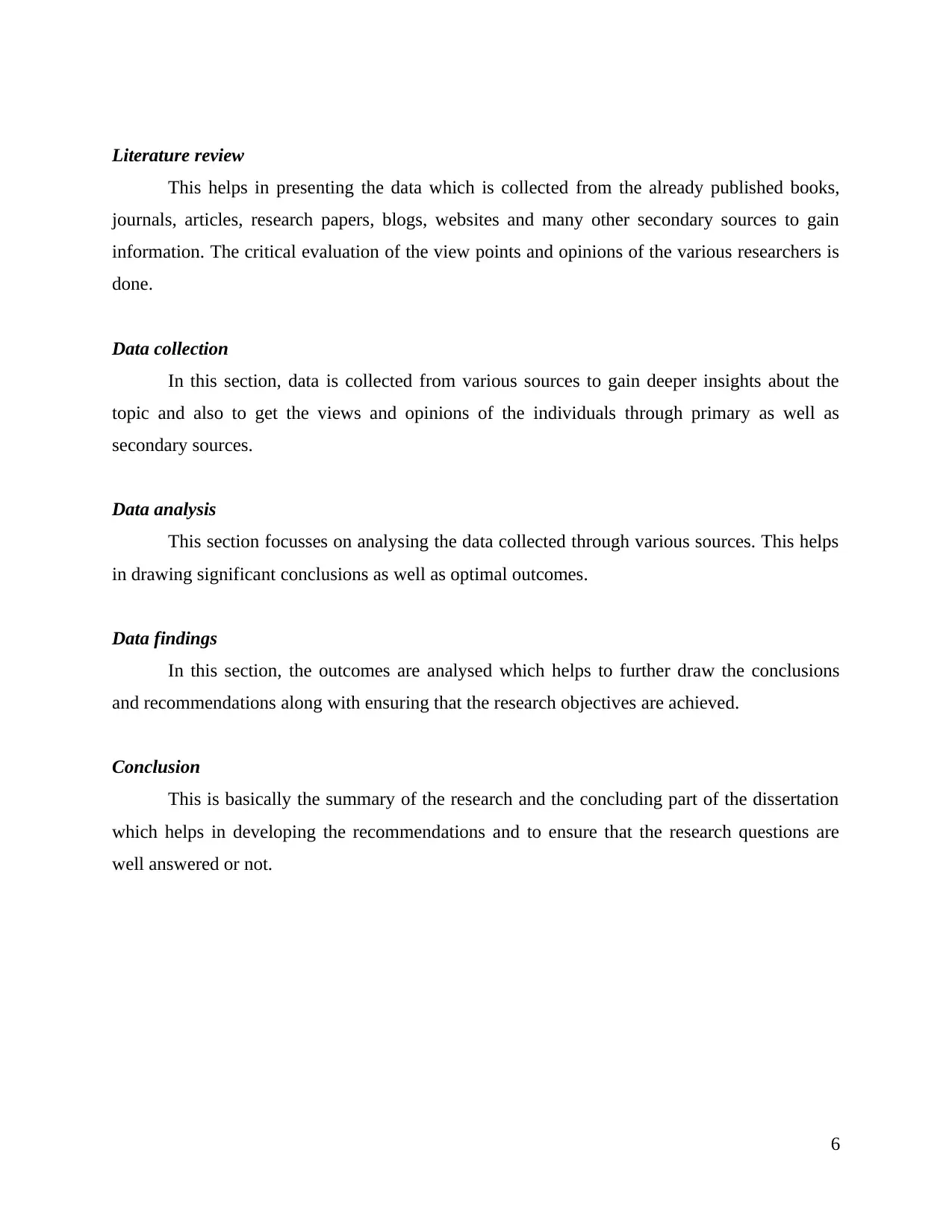
Literature review
This helps in presenting the data which is collected from the already published books,
journals, articles, research papers, blogs, websites and many other secondary sources to gain
information. The critical evaluation of the view points and opinions of the various researchers is
done.
Data collection
In this section, data is collected from various sources to gain deeper insights about the
topic and also to get the views and opinions of the individuals through primary as well as
secondary sources.
Data analysis
This section focusses on analysing the data collected through various sources. This helps
in drawing significant conclusions as well as optimal outcomes.
Data findings
In this section, the outcomes are analysed which helps to further draw the conclusions
and recommendations along with ensuring that the research objectives are achieved.
Conclusion
This is basically the summary of the research and the concluding part of the dissertation
which helps in developing the recommendations and to ensure that the research questions are
well answered or not.
6
This helps in presenting the data which is collected from the already published books,
journals, articles, research papers, blogs, websites and many other secondary sources to gain
information. The critical evaluation of the view points and opinions of the various researchers is
done.
Data collection
In this section, data is collected from various sources to gain deeper insights about the
topic and also to get the views and opinions of the individuals through primary as well as
secondary sources.
Data analysis
This section focusses on analysing the data collected through various sources. This helps
in drawing significant conclusions as well as optimal outcomes.
Data findings
In this section, the outcomes are analysed which helps to further draw the conclusions
and recommendations along with ensuring that the research objectives are achieved.
Conclusion
This is basically the summary of the research and the concluding part of the dissertation
which helps in developing the recommendations and to ensure that the research questions are
well answered or not.
6
⊘ This is a preview!⊘
Do you want full access?
Subscribe today to unlock all pages.

Trusted by 1+ million students worldwide
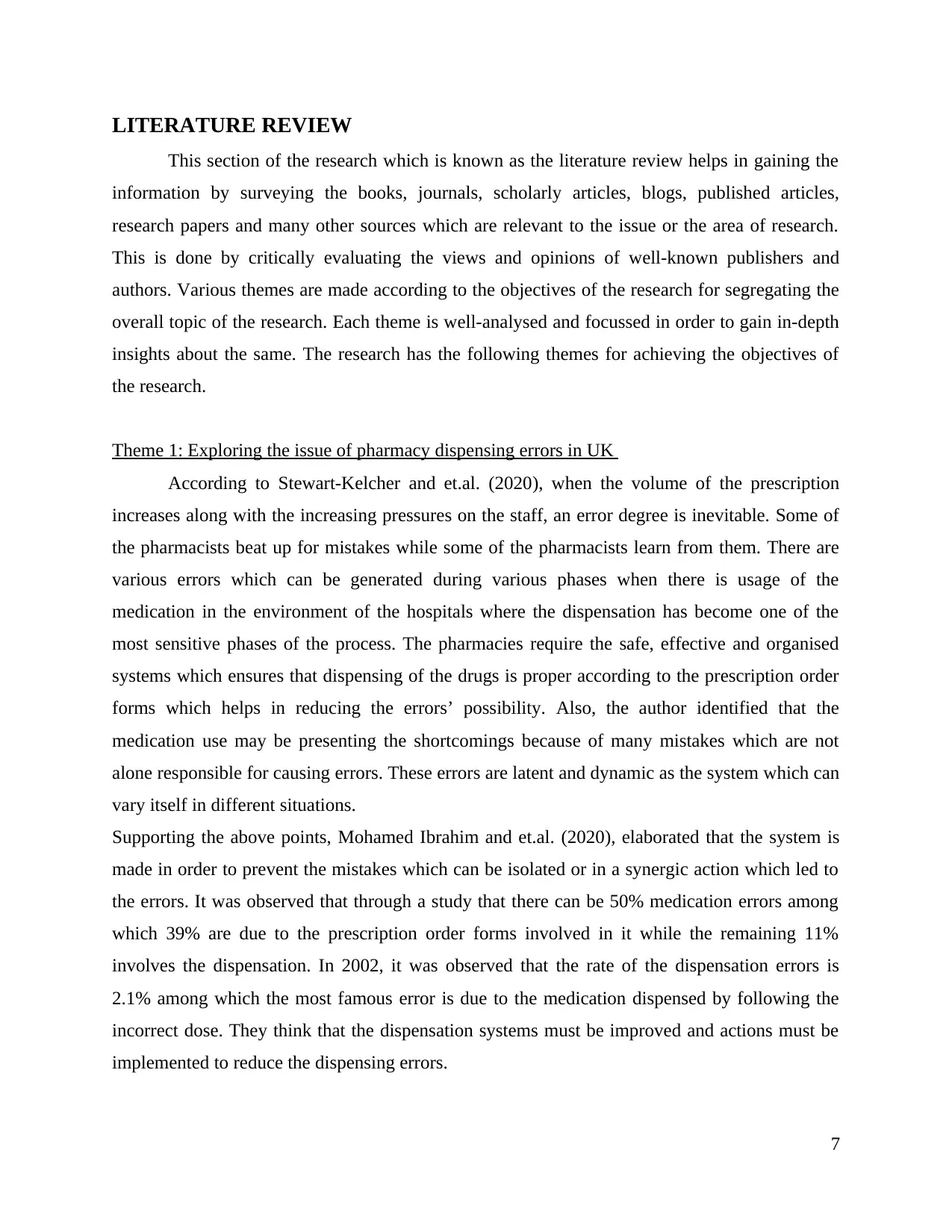
LITERATURE REVIEW
This section of the research which is known as the literature review helps in gaining the
information by surveying the books, journals, scholarly articles, blogs, published articles,
research papers and many other sources which are relevant to the issue or the area of research.
This is done by critically evaluating the views and opinions of well-known publishers and
authors. Various themes are made according to the objectives of the research for segregating the
overall topic of the research. Each theme is well-analysed and focussed in order to gain in-depth
insights about the same. The research has the following themes for achieving the objectives of
the research.
Theme 1: Exploring the issue of pharmacy dispensing errors in UK
According to Stewart-Kelcher and et.al. (2020), when the volume of the prescription
increases along with the increasing pressures on the staff, an error degree is inevitable. Some of
the pharmacists beat up for mistakes while some of the pharmacists learn from them. There are
various errors which can be generated during various phases when there is usage of the
medication in the environment of the hospitals where the dispensation has become one of the
most sensitive phases of the process. The pharmacies require the safe, effective and organised
systems which ensures that dispensing of the drugs is proper according to the prescription order
forms which helps in reducing the errors’ possibility. Also, the author identified that the
medication use may be presenting the shortcomings because of many mistakes which are not
alone responsible for causing errors. These errors are latent and dynamic as the system which can
vary itself in different situations.
Supporting the above points, Mohamed Ibrahim and et.al. (2020), elaborated that the system is
made in order to prevent the mistakes which can be isolated or in a synergic action which led to
the errors. It was observed that through a study that there can be 50% medication errors among
which 39% are due to the prescription order forms involved in it while the remaining 11%
involves the dispensation. In 2002, it was observed that the rate of the dispensation errors is
2.1% among which the most famous error is due to the medication dispensed by following the
incorrect dose. They think that the dispensation systems must be improved and actions must be
implemented to reduce the dispensing errors.
7
This section of the research which is known as the literature review helps in gaining the
information by surveying the books, journals, scholarly articles, blogs, published articles,
research papers and many other sources which are relevant to the issue or the area of research.
This is done by critically evaluating the views and opinions of well-known publishers and
authors. Various themes are made according to the objectives of the research for segregating the
overall topic of the research. Each theme is well-analysed and focussed in order to gain in-depth
insights about the same. The research has the following themes for achieving the objectives of
the research.
Theme 1: Exploring the issue of pharmacy dispensing errors in UK
According to Stewart-Kelcher and et.al. (2020), when the volume of the prescription
increases along with the increasing pressures on the staff, an error degree is inevitable. Some of
the pharmacists beat up for mistakes while some of the pharmacists learn from them. There are
various errors which can be generated during various phases when there is usage of the
medication in the environment of the hospitals where the dispensation has become one of the
most sensitive phases of the process. The pharmacies require the safe, effective and organised
systems which ensures that dispensing of the drugs is proper according to the prescription order
forms which helps in reducing the errors’ possibility. Also, the author identified that the
medication use may be presenting the shortcomings because of many mistakes which are not
alone responsible for causing errors. These errors are latent and dynamic as the system which can
vary itself in different situations.
Supporting the above points, Mohamed Ibrahim and et.al. (2020), elaborated that the system is
made in order to prevent the mistakes which can be isolated or in a synergic action which led to
the errors. It was observed that through a study that there can be 50% medication errors among
which 39% are due to the prescription order forms involved in it while the remaining 11%
involves the dispensation. In 2002, it was observed that the rate of the dispensation errors is
2.1% among which the most famous error is due to the medication dispensed by following the
incorrect dose. They think that the dispensation systems must be improved and actions must be
implemented to reduce the dispensing errors.
7
Paraphrase This Document
Need a fresh take? Get an instant paraphrase of this document with our AI Paraphraser
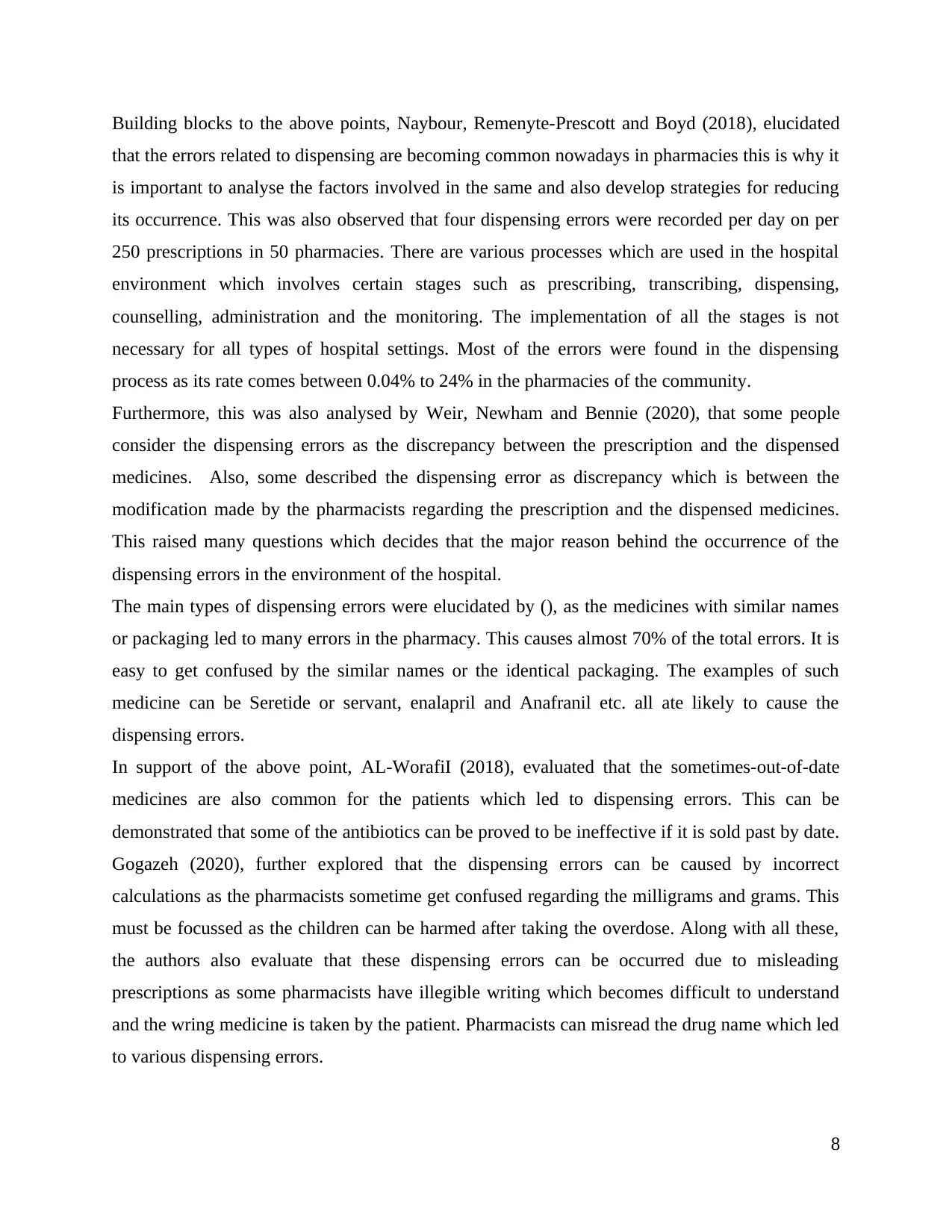
Building blocks to the above points, Naybour, Remenyte-Prescott and Boyd (2018), elucidated
that the errors related to dispensing are becoming common nowadays in pharmacies this is why it
is important to analyse the factors involved in the same and also develop strategies for reducing
its occurrence. This was also observed that four dispensing errors were recorded per day on per
250 prescriptions in 50 pharmacies. There are various processes which are used in the hospital
environment which involves certain stages such as prescribing, transcribing, dispensing,
counselling, administration and the monitoring. The implementation of all the stages is not
necessary for all types of hospital settings. Most of the errors were found in the dispensing
process as its rate comes between 0.04% to 24% in the pharmacies of the community.
Furthermore, this was also analysed by Weir, Newham and Bennie (2020), that some people
consider the dispensing errors as the discrepancy between the prescription and the dispensed
medicines. Also, some described the dispensing error as discrepancy which is between the
modification made by the pharmacists regarding the prescription and the dispensed medicines.
This raised many questions which decides that the major reason behind the occurrence of the
dispensing errors in the environment of the hospital.
The main types of dispensing errors were elucidated by (), as the medicines with similar names
or packaging led to many errors in the pharmacy. This causes almost 70% of the total errors. It is
easy to get confused by the similar names or the identical packaging. The examples of such
medicine can be Seretide or servant, enalapril and Anafranil etc. all ate likely to cause the
dispensing errors.
In support of the above point, AL-WorafiI (2018), evaluated that the sometimes-out-of-date
medicines are also common for the patients which led to dispensing errors. This can be
demonstrated that some of the antibiotics can be proved to be ineffective if it is sold past by date.
Gogazeh (2020), further explored that the dispensing errors can be caused by incorrect
calculations as the pharmacists sometime get confused regarding the milligrams and grams. This
must be focussed as the children can be harmed after taking the overdose. Along with all these,
the authors also evaluate that these dispensing errors can be occurred due to misleading
prescriptions as some pharmacists have illegible writing which becomes difficult to understand
and the wring medicine is taken by the patient. Pharmacists can misread the drug name which led
to various dispensing errors.
8
that the errors related to dispensing are becoming common nowadays in pharmacies this is why it
is important to analyse the factors involved in the same and also develop strategies for reducing
its occurrence. This was also observed that four dispensing errors were recorded per day on per
250 prescriptions in 50 pharmacies. There are various processes which are used in the hospital
environment which involves certain stages such as prescribing, transcribing, dispensing,
counselling, administration and the monitoring. The implementation of all the stages is not
necessary for all types of hospital settings. Most of the errors were found in the dispensing
process as its rate comes between 0.04% to 24% in the pharmacies of the community.
Furthermore, this was also analysed by Weir, Newham and Bennie (2020), that some people
consider the dispensing errors as the discrepancy between the prescription and the dispensed
medicines. Also, some described the dispensing error as discrepancy which is between the
modification made by the pharmacists regarding the prescription and the dispensed medicines.
This raised many questions which decides that the major reason behind the occurrence of the
dispensing errors in the environment of the hospital.
The main types of dispensing errors were elucidated by (), as the medicines with similar names
or packaging led to many errors in the pharmacy. This causes almost 70% of the total errors. It is
easy to get confused by the similar names or the identical packaging. The examples of such
medicine can be Seretide or servant, enalapril and Anafranil etc. all ate likely to cause the
dispensing errors.
In support of the above point, AL-WorafiI (2018), evaluated that the sometimes-out-of-date
medicines are also common for the patients which led to dispensing errors. This can be
demonstrated that some of the antibiotics can be proved to be ineffective if it is sold past by date.
Gogazeh (2020), further explored that the dispensing errors can be caused by incorrect
calculations as the pharmacists sometime get confused regarding the milligrams and grams. This
must be focussed as the children can be harmed after taking the overdose. Along with all these,
the authors also evaluate that these dispensing errors can be occurred due to misleading
prescriptions as some pharmacists have illegible writing which becomes difficult to understand
and the wring medicine is taken by the patient. Pharmacists can misread the drug name which led
to various dispensing errors.
8
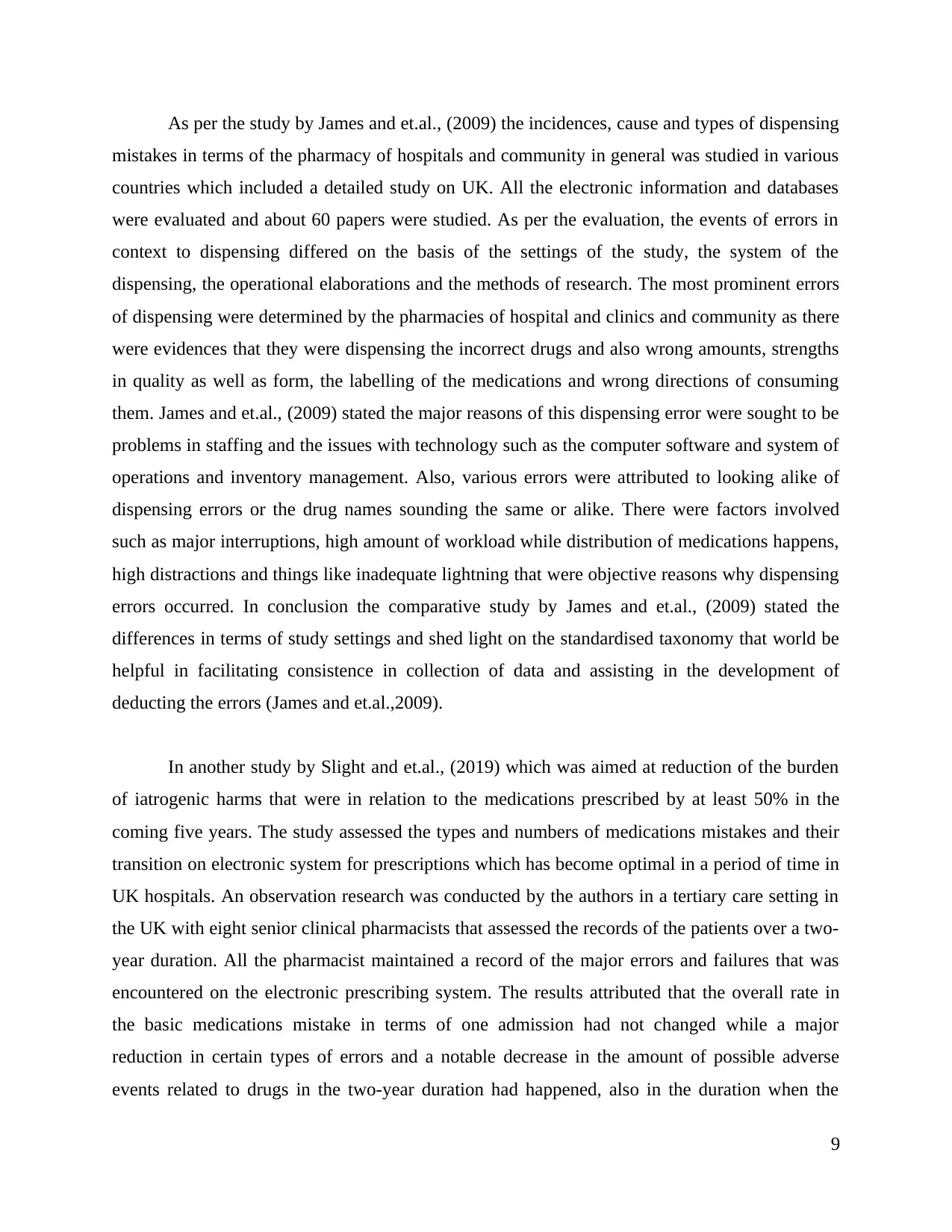
As per the study by James and et.al., (2009) the incidences, cause and types of dispensing
mistakes in terms of the pharmacy of hospitals and community in general was studied in various
countries which included a detailed study on UK. All the electronic information and databases
were evaluated and about 60 papers were studied. As per the evaluation, the events of errors in
context to dispensing differed on the basis of the settings of the study, the system of the
dispensing, the operational elaborations and the methods of research. The most prominent errors
of dispensing were determined by the pharmacies of hospital and clinics and community as there
were evidences that they were dispensing the incorrect drugs and also wrong amounts, strengths
in quality as well as form, the labelling of the medications and wrong directions of consuming
them. James and et.al., (2009) stated the major reasons of this dispensing error were sought to be
problems in staffing and the issues with technology such as the computer software and system of
operations and inventory management. Also, various errors were attributed to looking alike of
dispensing errors or the drug names sounding the same or alike. There were factors involved
such as major interruptions, high amount of workload while distribution of medications happens,
high distractions and things like inadequate lightning that were objective reasons why dispensing
errors occurred. In conclusion the comparative study by James and et.al., (2009) stated the
differences in terms of study settings and shed light on the standardised taxonomy that world be
helpful in facilitating consistence in collection of data and assisting in the development of
deducting the errors (James and et.al.,2009).
In another study by Slight and et.al., (2019) which was aimed at reduction of the burden
of iatrogenic harms that were in relation to the medications prescribed by at least 50% in the
coming five years. The study assessed the types and numbers of medications mistakes and their
transition on electronic system for prescriptions which has become optimal in a period of time in
UK hospitals. An observation research was conducted by the authors in a tertiary care setting in
the UK with eight senior clinical pharmacists that assessed the records of the patients over a two-
year duration. All the pharmacist maintained a record of the major errors and failures that was
encountered on the electronic prescribing system. The results attributed that the overall rate in
the basic medications mistake in terms of one admission had not changed while a major
reduction in certain types of errors and a notable decrease in the amount of possible adverse
events related to drugs in the two-year duration had happened, also in the duration when the
9
mistakes in terms of the pharmacy of hospitals and community in general was studied in various
countries which included a detailed study on UK. All the electronic information and databases
were evaluated and about 60 papers were studied. As per the evaluation, the events of errors in
context to dispensing differed on the basis of the settings of the study, the system of the
dispensing, the operational elaborations and the methods of research. The most prominent errors
of dispensing were determined by the pharmacies of hospital and clinics and community as there
were evidences that they were dispensing the incorrect drugs and also wrong amounts, strengths
in quality as well as form, the labelling of the medications and wrong directions of consuming
them. James and et.al., (2009) stated the major reasons of this dispensing error were sought to be
problems in staffing and the issues with technology such as the computer software and system of
operations and inventory management. Also, various errors were attributed to looking alike of
dispensing errors or the drug names sounding the same or alike. There were factors involved
such as major interruptions, high amount of workload while distribution of medications happens,
high distractions and things like inadequate lightning that were objective reasons why dispensing
errors occurred. In conclusion the comparative study by James and et.al., (2009) stated the
differences in terms of study settings and shed light on the standardised taxonomy that world be
helpful in facilitating consistence in collection of data and assisting in the development of
deducting the errors (James and et.al.,2009).
In another study by Slight and et.al., (2019) which was aimed at reduction of the burden
of iatrogenic harms that were in relation to the medications prescribed by at least 50% in the
coming five years. The study assessed the types and numbers of medications mistakes and their
transition on electronic system for prescriptions which has become optimal in a period of time in
UK hospitals. An observation research was conducted by the authors in a tertiary care setting in
the UK with eight senior clinical pharmacists that assessed the records of the patients over a two-
year duration. All the pharmacist maintained a record of the major errors and failures that was
encountered on the electronic prescribing system. The results attributed that the overall rate in
the basic medications mistake in terms of one admission had not changed while a major
reduction in certain types of errors and a notable decrease in the amount of possible adverse
events related to drugs in the two-year duration had happened, also in the duration when the
9
⊘ This is a preview!⊘
Do you want full access?
Subscribe today to unlock all pages.

Trusted by 1+ million students worldwide
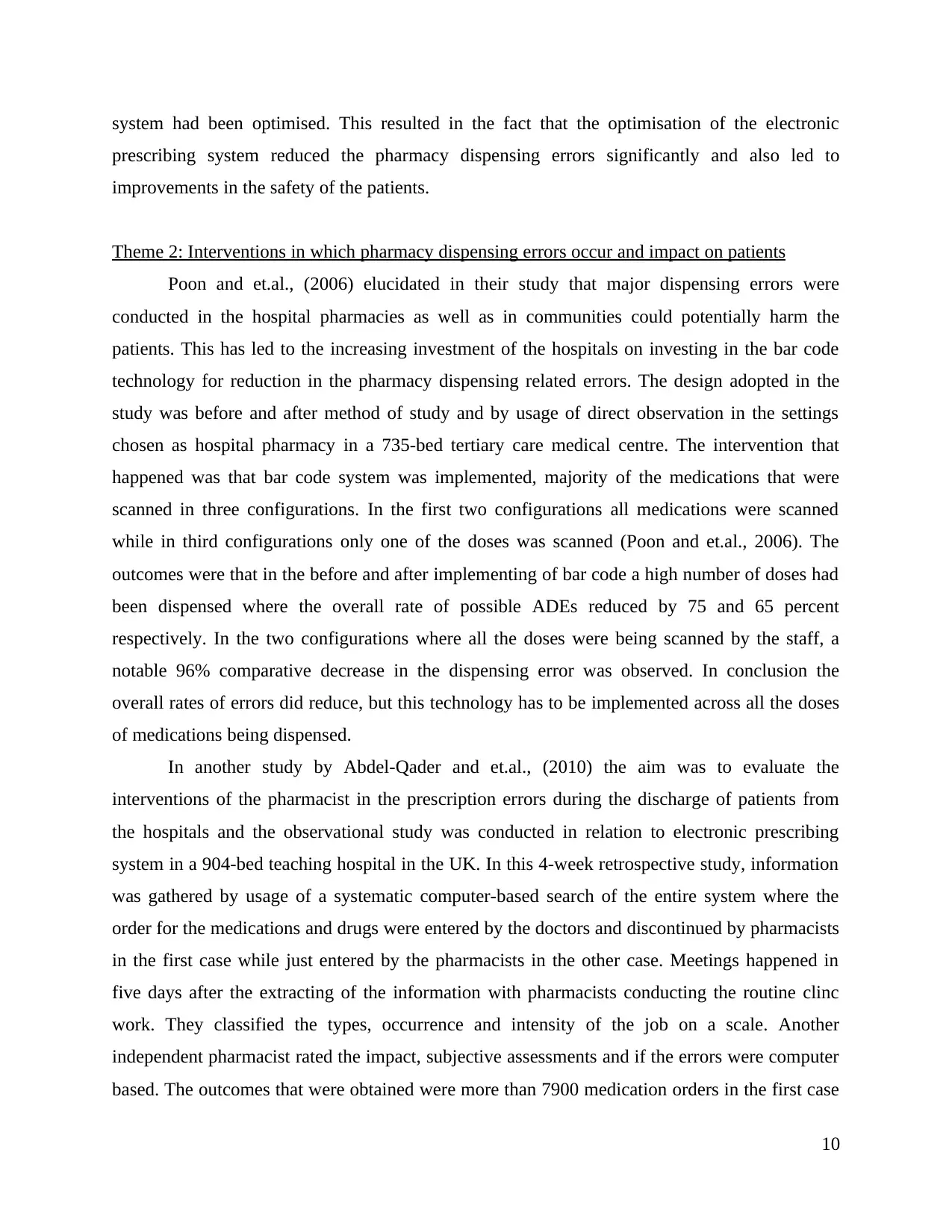
system had been optimised. This resulted in the fact that the optimisation of the electronic
prescribing system reduced the pharmacy dispensing errors significantly and also led to
improvements in the safety of the patients.
Theme 2: Interventions in which pharmacy dispensing errors occur and impact on patients
Poon and et.al., (2006) elucidated in their study that major dispensing errors were
conducted in the hospital pharmacies as well as in communities could potentially harm the
patients. This has led to the increasing investment of the hospitals on investing in the bar code
technology for reduction in the pharmacy dispensing related errors. The design adopted in the
study was before and after method of study and by usage of direct observation in the settings
chosen as hospital pharmacy in a 735-bed tertiary care medical centre. The intervention that
happened was that bar code system was implemented, majority of the medications that were
scanned in three configurations. In the first two configurations all medications were scanned
while in third configurations only one of the doses was scanned (Poon and et.al., 2006). The
outcomes were that in the before and after implementing of bar code a high number of doses had
been dispensed where the overall rate of possible ADEs reduced by 75 and 65 percent
respectively. In the two configurations where all the doses were being scanned by the staff, a
notable 96% comparative decrease in the dispensing error was observed. In conclusion the
overall rates of errors did reduce, but this technology has to be implemented across all the doses
of medications being dispensed.
In another study by Abdel-Qader and et.al., (2010) the aim was to evaluate the
interventions of the pharmacist in the prescription errors during the discharge of patients from
the hospitals and the observational study was conducted in relation to electronic prescribing
system in a 904-bed teaching hospital in the UK. In this 4-week retrospective study, information
was gathered by usage of a systematic computer-based search of the entire system where the
order for the medications and drugs were entered by the doctors and discontinued by pharmacists
in the first case while just entered by the pharmacists in the other case. Meetings happened in
five days after the extracting of the information with pharmacists conducting the routine clinc
work. They classified the types, occurrence and intensity of the job on a scale. Another
independent pharmacist rated the impact, subjective assessments and if the errors were computer
based. The outcomes that were obtained were more than 7900 medication orders in the first case
10
prescribing system reduced the pharmacy dispensing errors significantly and also led to
improvements in the safety of the patients.
Theme 2: Interventions in which pharmacy dispensing errors occur and impact on patients
Poon and et.al., (2006) elucidated in their study that major dispensing errors were
conducted in the hospital pharmacies as well as in communities could potentially harm the
patients. This has led to the increasing investment of the hospitals on investing in the bar code
technology for reduction in the pharmacy dispensing related errors. The design adopted in the
study was before and after method of study and by usage of direct observation in the settings
chosen as hospital pharmacy in a 735-bed tertiary care medical centre. The intervention that
happened was that bar code system was implemented, majority of the medications that were
scanned in three configurations. In the first two configurations all medications were scanned
while in third configurations only one of the doses was scanned (Poon and et.al., 2006). The
outcomes were that in the before and after implementing of bar code a high number of doses had
been dispensed where the overall rate of possible ADEs reduced by 75 and 65 percent
respectively. In the two configurations where all the doses were being scanned by the staff, a
notable 96% comparative decrease in the dispensing error was observed. In conclusion the
overall rates of errors did reduce, but this technology has to be implemented across all the doses
of medications being dispensed.
In another study by Abdel-Qader and et.al., (2010) the aim was to evaluate the
interventions of the pharmacist in the prescription errors during the discharge of patients from
the hospitals and the observational study was conducted in relation to electronic prescribing
system in a 904-bed teaching hospital in the UK. In this 4-week retrospective study, information
was gathered by usage of a systematic computer-based search of the entire system where the
order for the medications and drugs were entered by the doctors and discontinued by pharmacists
in the first case while just entered by the pharmacists in the other case. Meetings happened in
five days after the extracting of the information with pharmacists conducting the routine clinc
work. They classified the types, occurrence and intensity of the job on a scale. Another
independent pharmacist rated the impact, subjective assessments and if the errors were computer
based. The outcomes that were obtained were more than 7900 medication orders in the first case
10
Paraphrase This Document
Need a fresh take? Get an instant paraphrase of this document with our AI Paraphraser
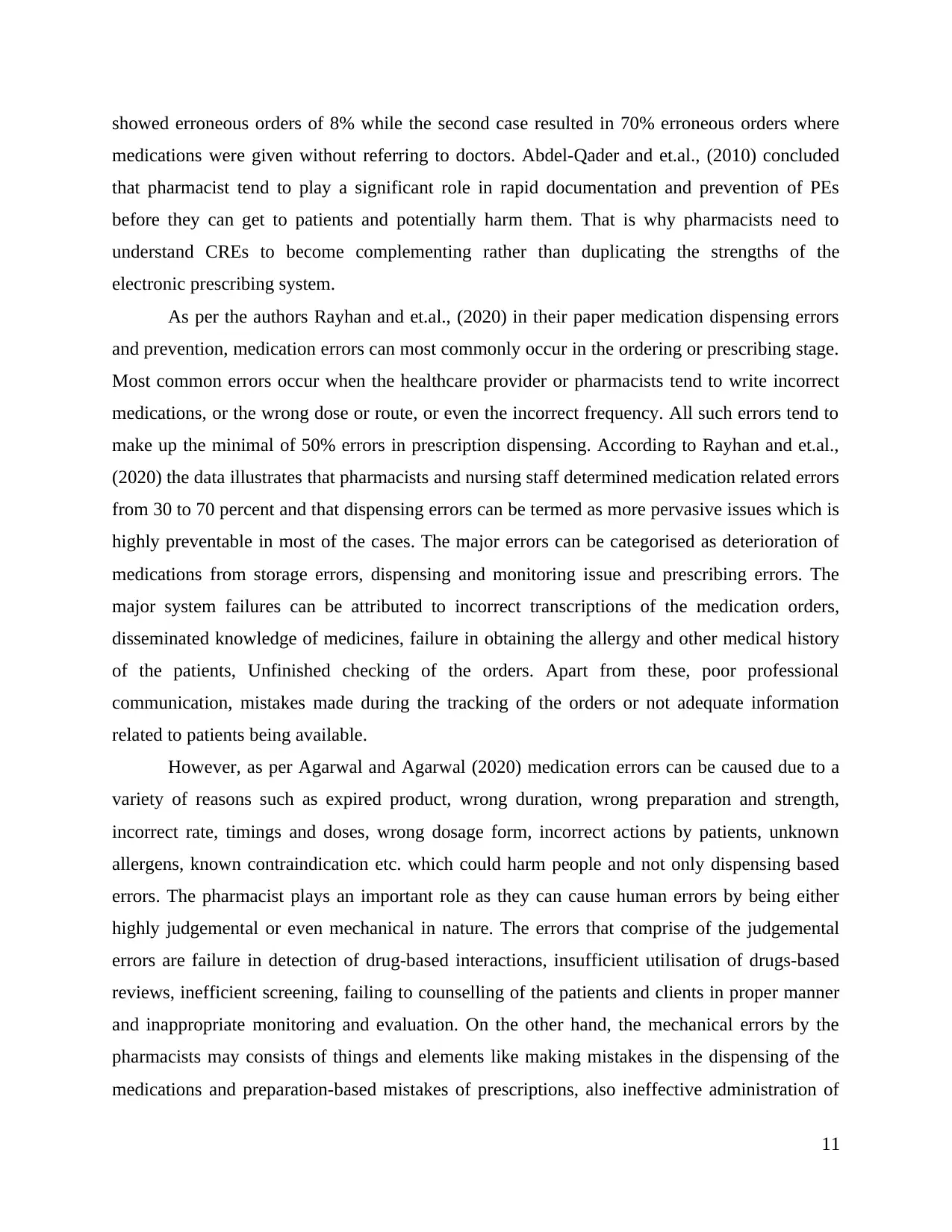
showed erroneous orders of 8% while the second case resulted in 70% erroneous orders where
medications were given without referring to doctors. Abdel-Qader and et.al., (2010) concluded
that pharmacist tend to play a significant role in rapid documentation and prevention of PEs
before they can get to patients and potentially harm them. That is why pharmacists need to
understand CREs to become complementing rather than duplicating the strengths of the
electronic prescribing system.
As per the authors Rayhan and et.al., (2020) in their paper medication dispensing errors
and prevention, medication errors can most commonly occur in the ordering or prescribing stage.
Most common errors occur when the healthcare provider or pharmacists tend to write incorrect
medications, or the wrong dose or route, or even the incorrect frequency. All such errors tend to
make up the minimal of 50% errors in prescription dispensing. According to Rayhan and et.al.,
(2020) the data illustrates that pharmacists and nursing staff determined medication related errors
from 30 to 70 percent and that dispensing errors can be termed as more pervasive issues which is
highly preventable in most of the cases. The major errors can be categorised as deterioration of
medications from storage errors, dispensing and monitoring issue and prescribing errors. The
major system failures can be attributed to incorrect transcriptions of the medication orders,
disseminated knowledge of medicines, failure in obtaining the allergy and other medical history
of the patients, Unfinished checking of the orders. Apart from these, poor professional
communication, mistakes made during the tracking of the orders or not adequate information
related to patients being available.
However, as per Agarwal and Agarwal (2020) medication errors can be caused due to a
variety of reasons such as expired product, wrong duration, wrong preparation and strength,
incorrect rate, timings and doses, wrong dosage form, incorrect actions by patients, unknown
allergens, known contraindication etc. which could harm people and not only dispensing based
errors. The pharmacist plays an important role as they can cause human errors by being either
highly judgemental or even mechanical in nature. The errors that comprise of the judgemental
errors are failure in detection of drug-based interactions, insufficient utilisation of drugs-based
reviews, inefficient screening, failing to counselling of the patients and clients in proper manner
and inappropriate monitoring and evaluation. On the other hand, the mechanical errors by the
pharmacists may consists of things and elements like making mistakes in the dispensing of the
medications and preparation-based mistakes of prescriptions, also ineffective administration of
11
medications were given without referring to doctors. Abdel-Qader and et.al., (2010) concluded
that pharmacist tend to play a significant role in rapid documentation and prevention of PEs
before they can get to patients and potentially harm them. That is why pharmacists need to
understand CREs to become complementing rather than duplicating the strengths of the
electronic prescribing system.
As per the authors Rayhan and et.al., (2020) in their paper medication dispensing errors
and prevention, medication errors can most commonly occur in the ordering or prescribing stage.
Most common errors occur when the healthcare provider or pharmacists tend to write incorrect
medications, or the wrong dose or route, or even the incorrect frequency. All such errors tend to
make up the minimal of 50% errors in prescription dispensing. According to Rayhan and et.al.,
(2020) the data illustrates that pharmacists and nursing staff determined medication related errors
from 30 to 70 percent and that dispensing errors can be termed as more pervasive issues which is
highly preventable in most of the cases. The major errors can be categorised as deterioration of
medications from storage errors, dispensing and monitoring issue and prescribing errors. The
major system failures can be attributed to incorrect transcriptions of the medication orders,
disseminated knowledge of medicines, failure in obtaining the allergy and other medical history
of the patients, Unfinished checking of the orders. Apart from these, poor professional
communication, mistakes made during the tracking of the orders or not adequate information
related to patients being available.
However, as per Agarwal and Agarwal (2020) medication errors can be caused due to a
variety of reasons such as expired product, wrong duration, wrong preparation and strength,
incorrect rate, timings and doses, wrong dosage form, incorrect actions by patients, unknown
allergens, known contraindication etc. which could harm people and not only dispensing based
errors. The pharmacist plays an important role as they can cause human errors by being either
highly judgemental or even mechanical in nature. The errors that comprise of the judgemental
errors are failure in detection of drug-based interactions, insufficient utilisation of drugs-based
reviews, inefficient screening, failing to counselling of the patients and clients in proper manner
and inappropriate monitoring and evaluation. On the other hand, the mechanical errors by the
pharmacists may consists of things and elements like making mistakes in the dispensing of the
medications and preparation-based mistakes of prescriptions, also ineffective administration of
11
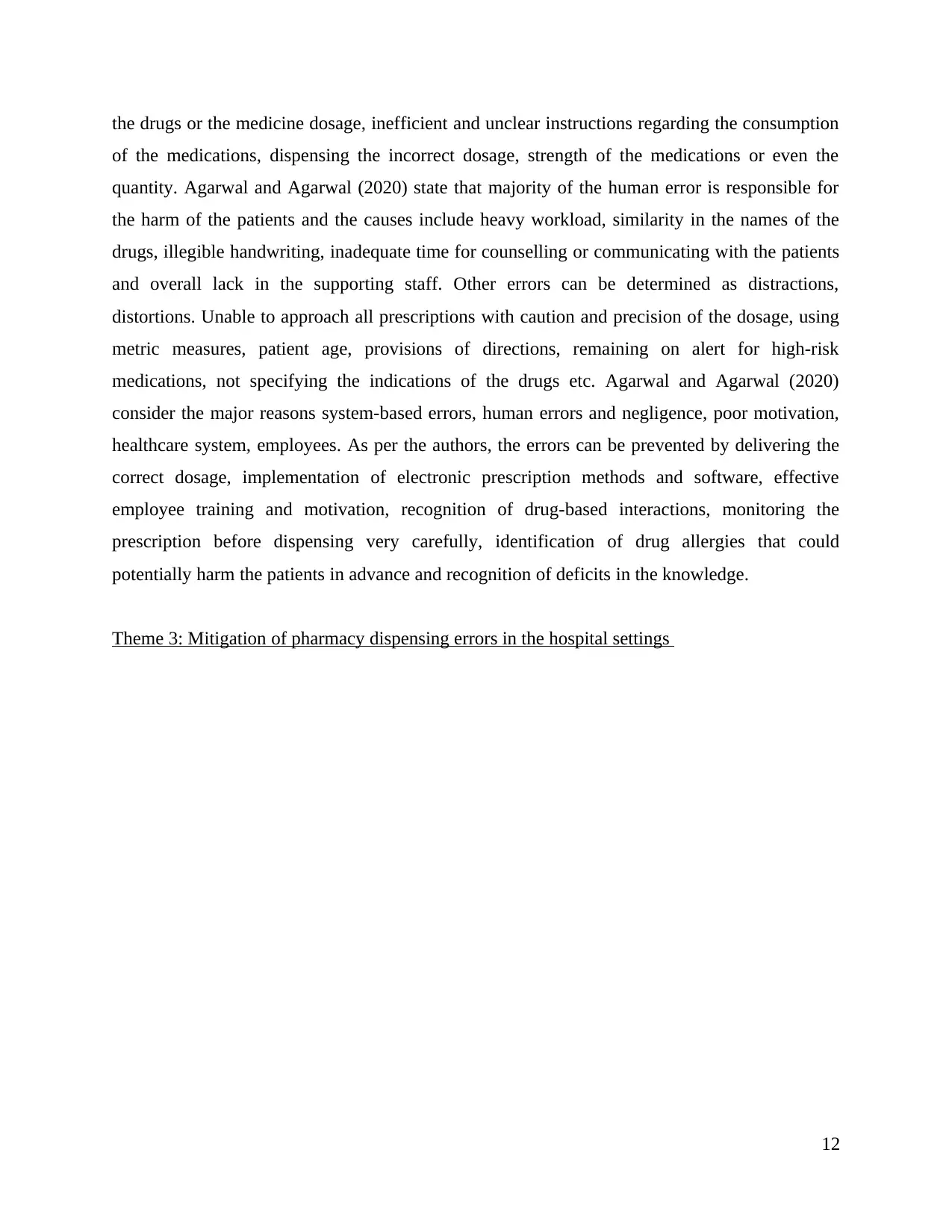
the drugs or the medicine dosage, inefficient and unclear instructions regarding the consumption
of the medications, dispensing the incorrect dosage, strength of the medications or even the
quantity. Agarwal and Agarwal (2020) state that majority of the human error is responsible for
the harm of the patients and the causes include heavy workload, similarity in the names of the
drugs, illegible handwriting, inadequate time for counselling or communicating with the patients
and overall lack in the supporting staff. Other errors can be determined as distractions,
distortions. Unable to approach all prescriptions with caution and precision of the dosage, using
metric measures, patient age, provisions of directions, remaining on alert for high-risk
medications, not specifying the indications of the drugs etc. Agarwal and Agarwal (2020)
consider the major reasons system-based errors, human errors and negligence, poor motivation,
healthcare system, employees. As per the authors, the errors can be prevented by delivering the
correct dosage, implementation of electronic prescription methods and software, effective
employee training and motivation, recognition of drug-based interactions, monitoring the
prescription before dispensing very carefully, identification of drug allergies that could
potentially harm the patients in advance and recognition of deficits in the knowledge.
Theme 3: Mitigation of pharmacy dispensing errors in the hospital settings
12
of the medications, dispensing the incorrect dosage, strength of the medications or even the
quantity. Agarwal and Agarwal (2020) state that majority of the human error is responsible for
the harm of the patients and the causes include heavy workload, similarity in the names of the
drugs, illegible handwriting, inadequate time for counselling or communicating with the patients
and overall lack in the supporting staff. Other errors can be determined as distractions,
distortions. Unable to approach all prescriptions with caution and precision of the dosage, using
metric measures, patient age, provisions of directions, remaining on alert for high-risk
medications, not specifying the indications of the drugs etc. Agarwal and Agarwal (2020)
consider the major reasons system-based errors, human errors and negligence, poor motivation,
healthcare system, employees. As per the authors, the errors can be prevented by delivering the
correct dosage, implementation of electronic prescription methods and software, effective
employee training and motivation, recognition of drug-based interactions, monitoring the
prescription before dispensing very carefully, identification of drug allergies that could
potentially harm the patients in advance and recognition of deficits in the knowledge.
Theme 3: Mitigation of pharmacy dispensing errors in the hospital settings
12
⊘ This is a preview!⊘
Do you want full access?
Subscribe today to unlock all pages.

Trusted by 1+ million students worldwide
1 out of 20
Related Documents
Your All-in-One AI-Powered Toolkit for Academic Success.
+13062052269
info@desklib.com
Available 24*7 on WhatsApp / Email
![[object Object]](/_next/static/media/star-bottom.7253800d.svg)
Unlock your academic potential
Copyright © 2020–2025 A2Z Services. All Rights Reserved. Developed and managed by ZUCOL.




